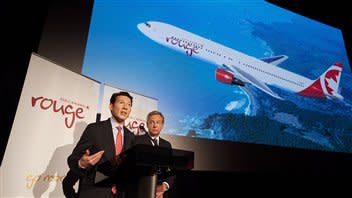Air Canada rouge defends partly-employee-paid Disney training

Air Canada's new leisure airline is taking a different approach to customer service, but one that's drawn the ire of their flight attendants' union.
The Toronto Star acquired a memo sent to the first 150 flight attendants hired by Air Canada rouge (small "r"), laying out plans for a training program hosted by the Disney Institute in Orlando, Fla.
The airline's director of inflight service, Annette Anand, said that the company "saw (Disney) as the Harvard of customer service training, and we wanted to align ourselves with that approach."
She said the company wants to create a "relaxed, comfortable approach" to service, not necessarily the hey-how-are-ya, folksy attitude fostered by rival WestJet.
While an investment in high-quality customer service could pay dividends for the new brand, exactly where that investment is coming from is raising some eyebrows.
Rouge flight attendants will have $49 deducted from their pay every month for up to three years—a total of $1,764—to participate in the program. If they leave the company within those three years, they'll still be on the hook for the remainder of that cost.
According to the Air Canada rouge Twitter account, the flight attendants contributions are to pay for "incidentals while in Florida," not the actual training:
@schuurman1979 Hi Steve, As mentioned Rouge is paying for the training, f/a's are covering only the cost of incidentals while in Florida
— Air Canada Rouge (@AirCanadarouge) May 29, 2013
(What remains unclear, though, is how that set fee of $49 a month covers "incidentals," which usually includes small expenses such as restaurant bills, cab fares, etc.)
In a statement, the CUPE component representing Air Canada's flight attendants called the decision "another case of corporations downloading costs to the employees to increase corporate profits," while Laura Frangella, an HR consultant with Toronto-based firm FocusedHR called it "a bit odd, to ask them to make a commitment of almost $2,000 up front."
Anand defended the decision, saying that participation in the Disney training program was a "personal investment in yourself," suggesting the skills learned through the highly-regarded training school will easily transfer to "any other position in the customer service industry." The same message was passed along in the memo Anand wrote to the new hires. "We’re making a significant investment and in asking to you to cover a small portion of the incidental cost, you’re also investing in your future," she wrote.
The trainees will be paid minimum-wage for the duration of the program. Upon completion, they'll earn $22.99 per hour as a rouge flight attendant.
The idea behind Air Canada rouge is to offer a lower-cost alternative for several international destinations by changing their focus from the traditional business traveler to what they term "leisure traveler."
This means a change in style and attitude for their service staff. Flight attendant uniforms will be much more casual, with relatively-basic burgundy tops and grey pants, with shoes from Canadian designer John Fluevog.
The cost structure of the airline is based around high-density seating arrangements and lower wages and benefits for their employees—which raises an important question about their plans for improved customer service.
As effective as Disney's approach to customer service is, it's questionable whether those skills are going to translate to the day-to-day service of an airline where lower employee compensation is built in to the cost structure. "There’s always that difficult assessment to make, if training has been transferred to the workplace," said Frangella.
"Is (the Disney training) going to be transferred into their job description, into their performance appraisal? If not, will it mean anything?"
Frangella did point out that most studies show little correlation between employee engagement and wages; a sense of feeling valued and cared for by management tends to be more effective in fostering dedicated employees than simply a bigger paycheque.
People love to complain about airline service, whether over a grumpy group of attendants, a condescending scolding for wearing the wrong headphones at the wrong time, stale crackers, whatever. If rouge's partnership with Disney succeeds in reducing those complaints, it could be a big boost to the brand.
On the other hand, if asking your employees to chip in for their own training ends up breeding contempt and disillusionment, rouge flight attendants may go rogue and look to make a connection to a competing carrier.
Anand told Yahoo! that the carrier held discussions and focus groups with successful applicants and they "didn't have anyone who flinched at (chipping in for training.)
"I'm quite confident we're doing the right thing."

 Yahoo Finance
Yahoo Finance 